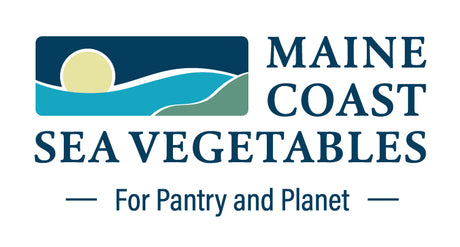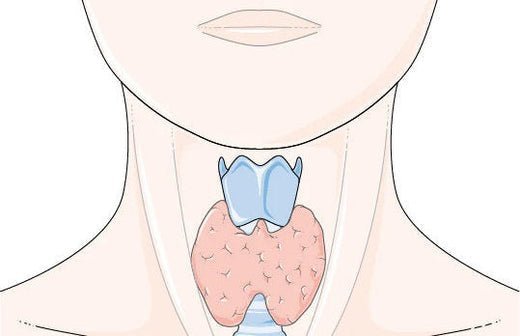Did you know January is National Thyroid Awareness Month? The American Thyroid Association (ATA) established National Thyroid Awareness Month in 1992. It also established World Thyroid Day on May 25 in partnership with the European Thyroid Association.
The thyroid is a butterfly-shaped gland in the front of the neck, and it has a mighty mission deserving of national and global recognition. The thyroid gland produces the hormones triiodothyronine (T3) and thyroxine (T4), which work together to regulate energy metabolism in nearly every human organ including the heart, lungs, digestive system, and reproductive system. The thyroid also produces calcitonin, which is needed in bone tissue to process calcium. The thyroid gland uses iodine to make these hormones, and too little or too much iodine can affect thyroid health.

Seaweed iodine has long had a special relationship with the thyroid gland, so it deserves special mention during January National Thyroid Awareness Month. Iodine was actually first discovered in seaweed by the French chemist Bernard Courtois while he was working to extract saltpeter from seaweed. Saltpeter is potassium nitrate, an essential gunpowder ingredient. The process of converting seaweed potassium salts into saltpeter involved adding sulfuric acid to seaweed ash. One day in 1811, Courtois accidentally added too much sulfuric acid, causing it to release a lovely but mysterious violet-colored vapor. The vapor precipitated into crystals, which Courtois eventually passed on to fellow chemists Gay-Lussac and H. Davy.
Upon further study, Gay-Lussac determined that the violet crystals were a new element, which he named iode from the Greek word “ioeides”, meaning violet colored. The new element was subsequently named iodine in the 1930’s. Gay-Lussac gave Curtois full credit for the discovery, although Davy tried to eclipse Gay-Lussac by allegedly backdating a paper he had presented on the same topic the day before Gay-Lussac’s presentation, even though it was actually presented the day after!

Meanwhile, J.F. Coindet, a Swiss physician, was using seaweed to treat goiter. Goiter is the condition of having an enlarged thyroid gland. It’s often caused by iodine deficiency, though people didn’t know that at the time. Certain conditions such as pregnancy, Grave’s disease, Hashimoto’s disease, and cancer can also cause goiters. Chinese herbalists and physicians had been using seaweed to treat goiter for 2,000 years, but it was Coindet who first theorized that seaweed iodine was the active ingredient. He confirmed his theory in 1819, just 8 years after Courtois’s discovery, by treating goiter patients with tincture of iodine extracted from seaweed.
As thyroid and medical iodine research progressed it became known that iodine could do more than treat goiters. Iodine was used to treat dozens of ailments and it became the new wonder drug of the 1800’s. Although today other treatments have replaced iodine for many disorders, it is still widely used in medicine, most notably in wound sanitation. It’s also now well understood that iodine plays a critical role in neonatal and infant brain development. Iodine deficiency during pregnancy and while nursing is the most common cause of preventable mental impairment worldwide.
Seaweed was the worlds’ sole iodine source between 1815 and 1865. Oarweed, also known as tangleweed and scientifically as Laminaria digitata, was a preferred species due to its high iodine content. Between 33 to 44 pounds of elemental iodine could be extracted per ton of oarweed. Other brown species such as rockweed and bladderwrack were also used. All three species were gathered and burned by the ton along the wrack line before being shipped to factories for iodine extraction.

Oarweed Laminaria digitata
In 1866, it was discovered that iodine could be extracted from caliche deposits (nitrate salts) in the Atacama region of Chile, and around 1925 iodine began to also be extracted from oil well brines. These new sources ended the seaweed iodine extraction industry, but seaweed continues to be a preferred source of nutritional iodine for many. The iodine in seaweed is readily absorbed by humans. One study found that seaweed was an important source of iodine for the Inuit people of the Arctic, whose diet would otherwise be iodine deficient. Obtaining iodine from non-industrial sources, such as sea vegetables, appeals to many as a natural alternative.
Iodine content varies widely between sea vegetable species. Sugar kelp in all forms is one of the most iodine rich, containing about 2,800mcg (micrograms) per gram. At the other end of the scale is sea lettuce, which typically has about 37mcg per gram. Many customers prefer bladderwrack for their iodine intake because its typical content of 388mcg per gram means they can get double the daily recommended intake with one gram (about1/4 tsp) of bladderwrack granules. The granules can be added to salads, smoothies, or other recipes to add umami, minerals, and iodine.
Iodine is essential for thyroid and human health. The recommended daily iodine intake in adults is 150mcg, but pregnant and lactating women are advised to get more to ensure proper brain development in their babies; 220mcg during pregnancy and 290mcg while lactating. The tolerable upper intake level (UL) is the amount most people can safely consume every day without suffering adverse consequences. In the U.S., the UL is 1,100mcg, while in Europe it’s 600mcg per day. Europe took a more cautious approach than the U.S. when interpreting the same data.
Symptoms of excessive iodine intake are similar to those of deficiency, including goiter, elevated TSH levels, and hypothyroidism. For most people, however, it’s fine to occasionally exceed 1,100mcg, and in general iodine deficiency is considered more harmful than iodine excess. The National Institutes of Health has an informative iodine fact sheet available at this web site: https://ods.od.nih.gov/factsheets/Iodine-HealthProfessional/.
Interestingly, regular seaweed consumption may help the thyroid acclimate to high blood iodine levels. The Japanese people, whose traditional daily diet included 5-7 grams of seaweed, were estimated to consume between 1,000 – 3,000 mcg per day without experiencing adverse consequences. Also interestingly, researchers such as Jane Teas and others have attributed Japan’s low cancer rate, particularly of breast cancer, to seaweed consumption and iodine intake.
Worldwide, about 30% of all people don’t get enough iodine in their diet. In the U.S., mild to moderate iodine deficiency is common and appears to be increasing despite the use of iodized salt. Experts blame this on dietary patterns such as decreased salt intake and vegetarian diets, and on agricultural practices that lead to iodine deficient soils. One easy way to help ensure adequate iodine intake is to include sea vegetables in your diet on a regular basis. MSCV Sea Seasonings are an especially easy and convenient way to do this. They can be used as a salt substitute or in addition to regular table salt on just about anything…soups, salads, sandwiches, and dips to name a few.
You can also “take your seaweed” in capsule form. Quite a few companies now offer seaweed-based nutritional supplements, but MCSV was one of the earliest. Seaweed Support Original Formula and Seaweed Support Iodine Formula were developed over 20 years ago for customers who wanted to get the health benefits of seaweed in a convenient and consistent way. When taken as directed, either supplement contains enough iodine to meet the recommended intake without exceeding the upper limit of 1,100mcg. Two capsules of Seaweed Support Original Formula provide 190mcg of iodine, which is 127% of the daily value, while two capsules of Seaweed Support Iodine Formula provide 270mcg, or 180% of the daily value. Both capsules contain a blend of Alaria, sea lettuce, dulse, and bladderwrack, but Seaweed Support Iodine Formula also includes rockweed and blends the five species in a different proportion to boost iodine content.

The capsule itself is made from microcrystalline cellulose derived from wood fibers. No animal-based materials or processing aids are used in its production, there is no contact with any material of animal origin during manufacturing or processing, and animals are not used for testing. The seaweed in the capsules is 100% certified organic and sustainably harvested. This makes Seaweed Support suitable for vegetarians, vegans, and anyone else who cares deeply about sustainability. Vegans and vegetarians have to be especially careful to ensure adequate iodine intake because meat and fishery products are often good sources, while vegetable products may be lacking when grown in iodine deficient soils.
So, do your thyroid a favor and include some sea vegetables in your diet, whether as a whole food seasoning, or capsule. Besides being National Thyroid Awareness Month, January is also the month of New Year resolutions. We can’t think of a better resolution than one that improves your physical and mental health by eating sea vegetables!

